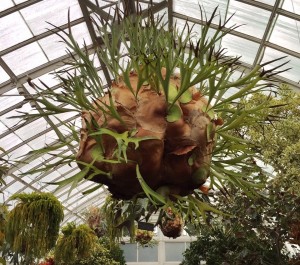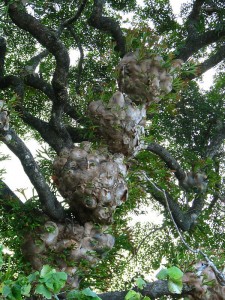Staghorn Ferns: Not So Alien
Posted in Horticulture on July 1 2015, by Christian Primeau
Christian Primeau is NYBG‘s Manager of the Enid A. Haupt Conservatory.

My office is situated in a most advantageous location adjacent to the ever-changing exhibition houses, my beloved desert houses, and steps from the breathtaking courtyard pools brimming with flowering lotus and water lilies. Voltaire might say “it is the best of all possible worlds.” Directly outside my door hang several beautiful specimens of Staghorn Fern (Platycerium sp.) As I sit at the computer, I am delighted by the amazed exclamations these plants elicit—so much so I feel compelled to write this post in hopes of answering the many wonderful questions visitors seem to have.
For the most part, patrons agree that the plant appears otherworldly. “It looks like some type of alien!” is a commonly overheard remark. I completely understand the sentiment, but these plants are most certainly of this world—found throughout the tropics and subtropics from the Philippines and Australia to Madagascar, Africa, and South America, to be exact. The way they grow in habitat and the unique way we display them in the Conservatory certainly present an unusual spectacle.
The Staghorn Fern is largely epiphytic in habit (epi being Greek for “upon” and phyton meaning “plant”). Essentially, the ferns live mounted in or on other plant life, though not in a parasitic manner. Usually found growing on the trunks of trees or in branch crotches, the plants exhibit a truly fascinating growth pattern. Staghorn Ferns have two distinct types of fronds: infertile and fertile. The often rounded infertile fronds grow clasped to the tree trunk, branch, or supporting structure like scales. Infertile fronds eventually fade to brown and die. New fronds build outward upon the old, year after year. Over time, dead infertile fronds create a vast mound of material which serves to trap nutrient-rich leaf litter and function as a stable platform for the proliferation of the fertile fronds. The thick, fleshy fertile fronds, which visitors recognize as the “foliage” of the plant, resemble the antlers of a moose, elk, or deer depending on species and bear the fern’s reproductive organs (sporangia) on their undersides.

In the Conservatory, we usually mount Platycerium on wood plaques or, as is the case outside my office, in or on heavy-duty wire hanging baskets lined with sphagnum moss. As the plants age, the infertile fronds envelop the baskets and continue to expand outward, eventually forming a weighty spheroid clump. The effect is tidier and far more symmetrical than one would observe in nature. Truthfully, it does resemble an alien pod of some sort. Rest assured, I have never witnessed anything extraterrestrial emerge from one; a small mouse once, but he was a native of the Bronx, I am certain of it.
Staghorn ferns are easy to find and grow, though you will need a bit of patience if you desire your own hulking Martian specimen. They will sometimes be sold potted in soil and will thrive if not overwatered, but are best grown as mounted specimens given their epiphytic habit. I encourage you all to try your hand with new, fascinating and “alien” plant life. There’s a universe of plants out there to explore and appreciate and, as always, there’s a world of plants to explore right here at the Enid A. Haupt Conservatory.

